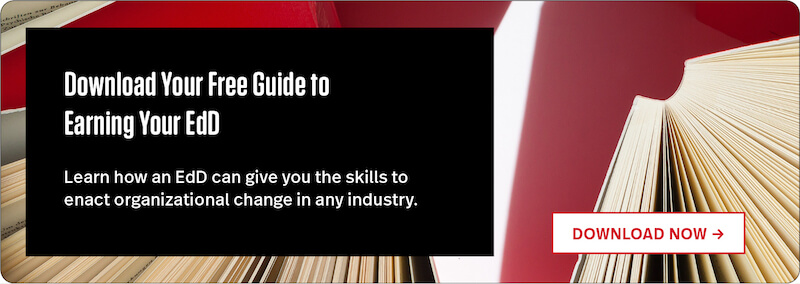It is no secret that there are vast disparities in the educational opportunities afforded to students across the nation. It’s more likely for students in affluent communities to have access to a wealth of academic resources and support while many students in lower-income communities are left struggling. The 2017 Brown Center Report on American Education calls out a troubling statistic: Schools with large populations, schools exclusively serving middle school grades, and schools serving a high proportion of poor or black students are all associated with elevated suspension rates for African-Americans.
New and veteran educators alike are striving for more inclusion—to help all students have the chance to realize their full potential. Teachers, administrators, and community organizers are taking the initiative to examine structural inequities and explore what an equitable classroom looks like. But what does inclusion really mean, and how can education professionals affect change in their organizations?
Download Our Free Guide to Earning Your EdD
Learn how an EdD can give you the skills to enact organizational change in any industry.
What is Inclusive Education?
Simply put, social justice looks at more than simply making the distribution of educational resources more fair and equitable. It involves learning practices to appreciate students and their families for who they are and what their life experiences are. Making education more inclusive can take many forms, such as:
- Cultivating a sense of belonging among first-generation college students
- Engaging and supporting girls in STEM programs
- Teaching students with learning disabilities in a traditional classroom
Billye Sankofa Waters, PhD, associate teaching professor in Northeastern University’s Doctor of Education program, shares her experience in social justice work across higher education. In addition to being an educator, Sankofa Waters is the author of We Can Speak for Ourselves: Parent Involvement and Ideologies of Black Mothers in Chicago. This work brings to life the real inequities in public education and ways we can help to enact meaningful change in our communities.
Her engrossing book explores the experiences of five black mothers of the same Chicago elementary school with respect to their relationship with the author—a qualitative researcher—over a period of two years. Sankofa Waters explains, “The goals of this work are to further a dialogue that questions how black women come to understand their relationship to education, the role of schooling, and to contribute to the growing literature and practices of mothers who work from their homes and respective communities. These narratives require all those concerned with the care and high expectations of our children to look within, across, and beyond systems to actively engage discourse that is multilingual and inclusive. This work speaks to all educators interested in issues of equity in education, particularly that within urban areas.”
Examples of Inclusive Education Around the Globe
There are many innovative programs around the world pursuing inclusive education where all students, regardless of challenges, are placed in age-appropriate general education classes.
Making schools more inclusive in Bulgaria
The One School for All program sought to move beyond the legacy of segregated education (special needs schools for children with special education needs or separate institutions for learners from ethnic minorities) and develop a model for an inclusive school environment.
Inclusive education and community-based support in Kenya
Embu Diocese organized a pilot project to provide inclusive education in 30 schools. A central feature of the program was the involvement of local communities in the inclusion of all children.
Bilingual education for hearing-impaired students in Madrid
Centro Educativo Ponce de Leon transformed methodologies, spaces, and classrooms to serve hearing-impaired students in an environment of inclusion.
Benefits of Inclusive Education
Education provides the pathway to economic and personal growth. Moreover, a solid education broadens the mind and empowers people to shape the world around them for the better. As noted in the report Key Issues in Education and Social Justice, “education plays a critical role in reducing poverty and inequality and promoting social mobility.” That is why educational inequalities are recognized as social injustices.
Even if you look beyond the clear societal benefits of bringing greater equity to education, there are compelling financial advantages as well. A report entitled, The Costs and Benefits of an Excellent Education for All of America’s Children, written by researchers from Columbia University, Princeton University, and the City University of New York, found that “each new high school graduate would yield a public benefit of $209,000 in higher government revenues and lower government spending for an overall investment of $82,000…The net economic benefit to the public is, therefore, $127,00 per student.”
Central Principles of Enacting Change in the Classroom
Sparking social change in education is often a long and highly complex journey. To do so, Sankofa Waters explains, educators need to focus on how to leverage power as individuals and how to leverage power collectively. Below are some key steps that can help educators engage in change productively.
1. Understand that there is no quick fix.
Sankofa Waters cautions her students, “We’re not going in to ‘save’ anyone…It’s common to want to go in and ‘fix it’. But you don’t just implement practices and assume everything will be better. It’s a process that takes a lot of people and a lot of time.”
Reflexivity is a big part of the work, she says. Don’t make assumptions about what people need or want. “Look at where you are healing and also where you may be harming,” she adds. “For example, you may be providing a service such as redesigning a curriculum that you feel is helpful but that may not necessarily be the case. You may be coming in as an educator and be excited to work as a change agent, but the first step is to understand what others want out of the exchange.”
2. Build a positionality statement.
Before embarking on a community outreach project or a research project, it can be helpful to create a positionality statement that explains your role within the work. This statement can help bring out your personal and professional experiences and identify any benefits or obstacles that they may bring to the work. It will describe both the position you bringing to a research task as well as the cultural, political, and social contexts that influence your own worldview. To create a positionality statement, Sankofa Waters encourages students to ask themselves:
- Are you ready to do this work?
- Who invited you?
- What skills do you have to contribute?
- What makes you passionate about it?
- What resources are available to your community?
- Where will you receive the most pushback if you’re trying to enact change? And how do you build a community to mitigate that? What does that look like?
- Where can you build bridges?
“If you can answer those questions, that gives you a stepping stone to look at different frameworks of practice,” Sankofa Waters says.
3. Recognize that parents’ voices matter.
“Inclusive education is not just about the classroom makeup but thoughtfully integrating the parents,” Sankofa Waters says. “We know parents are key stakeholders, but a lot of times in urban schools we’ve gotten used to the idea of telling parents how to do better with their children. Rarely do we have co-creation with parents. We position ourselves as the child expert and negate that they are an expert in their child. For example, if we put out a curriculum saying read to your child three times a day, and don’t recognize where that parent is coming from [their time constraints or other ways they contribute to their child’s learning], we’re already setting up a premise that they are a bad parent [for not completing a task we deem important]. Part of our work is understanding the strength of everyone that comes into the school and making sure we’re being collaborative. If we have buy-in from the parents, the whole world opens up.”
Ideas for Opening Dialogues with Parents
Start early. At one Chicago charter school, teachers asked parents if they could visit their family at home before the school year started. This gave them an opportunity to see the student in a comfortable place just being themselves, as well as a chance to meet the family, see the children’s learning space, and interact with the family in a meaningful way. Teachers asked open-ended questions: What do you need from me? What would you like me to know about your child? “This was a meaningful touchpoint for parents,” Sankofa Waters says.
Ask for feedback. When you plan meetings, consult a council of parents who can give input on the best times and locations for meetings. Don’t set up a meeting without asking them. These moms and dads can be an important vehicle for feedback to the administration.
Share positive feedback. “In some schools, parents don’t hear from the school unless something is wrong,” Sankofa Waters notes. Call or email parents to share their child’s successes or to let them know you recognize that their child put in extra effort on a project.
4. Build a curriculum that reflects the children in the school.
“Oftentimes we forget that children are stakeholders too,” Sankofa Waters says. “We have to value their narrative, and include their perspectives. We want the curriculum to reflect the children in the building. Students need to be able to see themselves. The school should not look like a separate place that’s different from what they learn at home.”
Blackgirl Gold Unapologetic, Inc. is one program achieving just that. Founded by Sankofa Waters, this Chicago-based nonprofit public charity leverages the power of young black women who are enrolled in undergraduate or graduate programs, integrating the literacies of hip-hop feminism with academic and creative writing techniques to affirm healthy self-images.
5. Own what you don’t know.
“Be ok with positioning yourself as a learner,” says Sankofa Waters. “As education experts, we move through the world as such, and a lot of times we don’t have the privilege of saying ‘I don’t know’. Don’t be afraid to ask questions and give yourself the space to learn something new.”
6. Find your tribe.
It’s essential to build an intellectual community of people who support your purpose. This may be fellow educators as well as parents, students, and community members. Working with peers in the classroom is another way to build your own network. For example, in Northeastern University’s Doctor of Education program, students come from different areas of practice and bring together different viewpoints.
“We’ve had professionals who were working to help veterans go back to school, others who were dealing with the trauma of girls [involved with] sex trafficking,” Sankofa Waters remarks. “We all dig into the texts at the same time and bring our own perspectives. Students often come back and share conversations they’ve had with their students or with faculty members or family and what they learned.”
7. Embrace a strong ethic of care.
“This type of work is intense,” Sankofa Waters says. “We know from a research perspective, what it is to give of yourself, and self-care is so important. If the work becomes too much, that’s not sustainable. You need to have space to be reflective or even just to tell jokes. I try to demonstrate this in my own actions to my students. I can’t tell them to care for themselves if I don’t set up space to do the same. We all need to be able to take a step back.”
Ready to impact change in your institution? Learn more about how an EdD can help you get there by downloading our guide below.







Related Articles
What is Learning Analytics & How Can it Be Used?
Reasons To Enroll in a Doctor of Education Program
Why I Chose to Pursue Learning Analytics